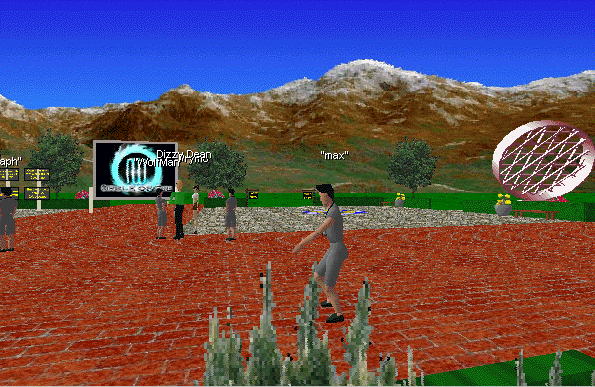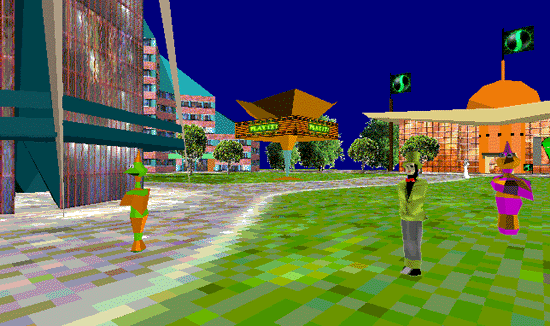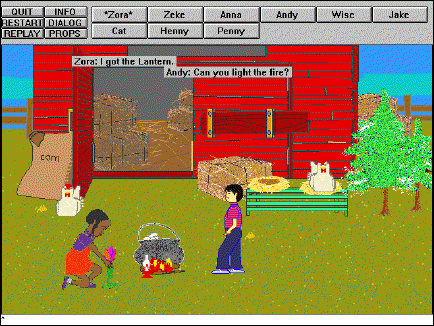
Schroeder , R. (1997)
'Networked Worlds: Social Aspects of Multi-User Virtual Reality
Technology'
Sociological Research Online, vol. 2,
no. 4, <http://www.socresonline.org.uk/2/4/5.html>
To cite articles published in Sociological Research Online, please reference the above information and include paragraph numbers if necessary
Received: 4/11/97 Accepted: 2/12/97 Published: 22/12/97
 Abstract
Abstract Introduction
Introduction
 Forerunners: Networked
Interactive Computer Graphics
Forerunners: Networked
Interactive Computer Graphics

 Networked Virtual
Reality
Networked Virtual
Reality
 Social Interaction In
Multi-User Desktop VR
Social Interaction In
Multi-User Desktop VR


 Conclusion
Conclusion

 Acknowledgements
Acknowledgements![]()
 Notes
Notes2 Habitat can be described as a second-person 2-D VR system, but again, this stretches the definition of VR since the sense of being 'present' in the virtual world is only via the avatar - the user has no first-person perspective on the virtual world. Habitat has recently been relaunched globally under the name Worldsaway, from which illustration 1 is taken. A key factor in the success of this system, as Dr.Kazutomo Fukuda (manager of the Cyberspace Systems Development department at Fujitsu, interview September 22, 1994) explained to me, are the telephone tariffs in different countries. In Japan, for example, the system was most popular late at night during the hours of 'off-peak' rates.
3 In Cybergate, it is also possible to design one's own avatar.
4 This greater sense of involvement of users can also be gathered from questionnaires: in pilot questionnaires for two separate studies (one in relation to Alphaworld and Cybergate, the other in relation to a networked VR system used in university research), for example, users were asked questions such as whether they feel 'immersed' in the virtual world, whether they feel the interaction with others is 'engaging', or whether they have sense 'of being' in the world or of 'being with others' in the virtual world. Their responses, both in scaled questions and in open questions which asked them to describe their experience, strongly support the idea that they have a sense of being inside the virtual world and with others. It needs to be added that these are only preliminary findings based on small samples.
5 The split between insiders and outsiders is, of course, not clear-cut; perhaps it would be better to envisage this divide as a continuum with two extremes. Some of the principles of micro-social or face-to-face interaction that are used here are summarized by Collins (1988: pp. 188 - 371). The discussion of the differentiation between communities in the following paragraph, and how this differentiation relates to status cultures and micro-social interaction, again, relies on Collins' theory (1975: pp. 49 - 160).
6 See Curtis (1992) and Turkle (1995). Common forms of misrepresenting oneself are to use several different names, to adopt a false gender, and the like. In this context it may also be useful to point to the studies carried out by Reeves and Nass, which found that people treat cartoon characters (1996: pp. 81 - 87) and other aspects of computer interfaces as more lifelike than they think - or than they are willing to admit.
7 A similar differentiation between 'newbies' and more experienced users can also be observed in MUD's, and it would be interesting to investigate the differences between MUD's and networked VR in this regard.
8 One indication of the popularity of these systems is that more than 250000 people have visited Alphaworld.
9 In relation to the internet and e-mail, some of these areas are discussed by Wellman (1996), McKenney et al (1992) and Nohria and Eccles (1992).
10 The idea that new technologies extend or intensify the means by which we manipulate the natural and social worlds is one that I have developed elsewhere (Schroeder, 1995, 1996; cf. Rogers, 1986.
11 'Bait and switch' has been mainly been used in the context of cable television in the United States, where, again, customers are hooked on certain programmes at a particular price which is then changed once the customers have come to rely on the service.
12 One of the main lessons of the trials which have used ExploreNet is that this differentiation into roles has not been successful among users, who have tended to ignore it (see Hughes and Moshell, 1995).
BALDWIN, Thomas; McVOY, D. Stevens and STEINFIELD, Charles (1996) Convergence: Integrating Media, Information and Communication. London: Sage.
CAWSON, Alan, HADDON, Leslie and MILES, Ian (1995) The Shape of Things to Consume: Delivering Information Technology into the Home. Aldershot: Avebury.
COLLINS, Randall (1975) Conflict Sociology - Towards an Explanatory Science. New York: Academic Press.
COLLINS, Randall (1988) Theoretical Sociology. New York: Harcourt Brace Jovanovich.
CURTIS, Pavel (1992) 'Mudding: Social Phenomena in Text-Based Virtual Realities'. Palo Alto: Xerox PARC (Unpublished technical report).
GARTON, Laura and WELLMAN, Barry (1995) 'Social Impacts Electronic Mail in Organizations: A Review of the Research Literature' in Brant Burleson (ed.), Communication Yearbook, vol.18, Sage: London, pp.434 - 453.
HOMANS, George (1961) Social Behaviour: Its Elementary Forms. London: Routledge and Kegan Paul.
HUGHES, Thomas (1987) 'The Evolution of Large Technological Systems' in Wiebe Bijker, Thomas Hughes and Trevor Pinch (editors), The Social Construction of Technological Systems. Cambridge, Mass.: MIT Press, pp. 51 - 82.
HUGHES, Charles and MOSHELL, Michael (1995) 'Shared Virtual Worlds for Education: The ExploreNet Experiment', <http://www.cs.ucf.edu/~ExploreNet/papers/VA.Experiment1195.html>.
KATZ, Warren (1994) 'Military Networking Technology Applied to Location-Based, Theme Park and Home Entertainment Systems', Computer Graphics, vol. 28, no. 2, pp. 110 - 2.
McKENNEY, James, ZACK, Michael and DOHERTY, Victor (1992) 'Complementary Communication Media: A Comparison of Electronic Mail and Face-To-Face Communication in a Programming Team' in Nithin Noria and Robert C. Eccles (editors), Networks and Organizations: Structure, Form and Action. Boston: Harvard Business School Press, pp. 262 - 287.
MORNINGSTAR, Chip and FARMER, Randall (1991) 'The Lessons of Lucasfilm's Habitat' in Michael Benedikt (editor), Cyberspace: First Steps. Cambridge, Mass.: MIT Press, pp. 273 - 301.
NOHRIA, Nitin and ECCLES, Robert (1992) 'Face-to-Face: Making Network Organizations Work' in Nithin Noria and Robert C. Eccles (editors), Networks and Organizations: Structure, Form and Action. Boston: Harvard Business School Press, pp. 288 - 308.
NORBERG, Arthur and O'NEILL, Judy (1996) Transforming Computer Technology: Information Processing at the Pentagon, 1962 - 1986. Baltimore: Johns Hopkins University Press.
O'NEILL, Judy (1995) 'The Role of ARPA in the Development of the ARPANET, 1961-1972', Annals of the History of Computing vol. 17, no. 4, pp. 76 - 81.
PRATT, David et al. (1995) 'NPSNET: Four User Interface Paradigms for Entity Control in a Virtual World', Journal of Intelligent Systems, vol. 5, nos. 2 - 4, pp. 89 - 109.
REEVES, Byron and NASS, Clifford (1996) The Media Equation: How People Treat Computers, Television and New Media Like Real People and Places. Cambridge: Cambridge University Press.
ROEHL, Bernie (1996) 'Shared Worlds', VR News, vol. 5, no. 8, pp. 14 - 19.
ROEHL, Bernie (1997) 'Shared Worlds', VR News, vol. 6, no. 9, pp. 10 - 15.
ROGERS, Everett (1986) Communication Technology: The New Media in Society. New York: Free Press.
SCHROEDER, Ralph (1995) 'Disenchantment and Its Discontents: Weberian Perspectives on Science and Technology', Sociological Review, vol. 43, no. 3, pp. 227 - 50.
SCHROEDER, Ralph. (1996) Possible Worlds: The Social Dynamic of Virtual Reality Technology. Boulder, Co.: Westview Press.
STYTZ, Martin R. (1994) 'An Overview of Current Virtual Reality Research and Development Projects by the United States Department of Defense' in Sandra Helsel (editor), Proceedings of the Fourth Annual Conference on Virtual Reality London: Mecklermedia, pp.152-159.
TURKLE, Sherry (1995) Life on the Screen: Identity in the Age of the Internet. New York: Simon & Schuster.
WELLMAN, Barry et al (1996) 'Computer Networks as Social Networks: Collaborative Work, Telework, and Virtual Community' in Annual Review of Sociology, vol. 22, pp. 213 - 38.